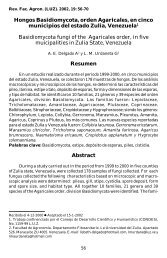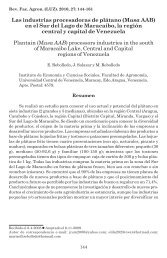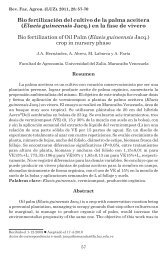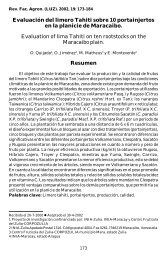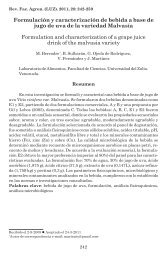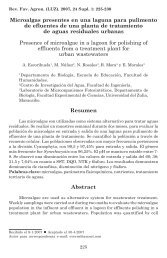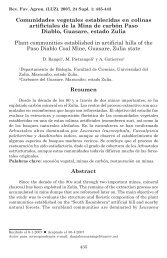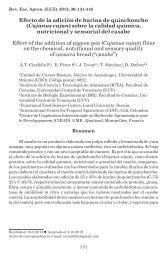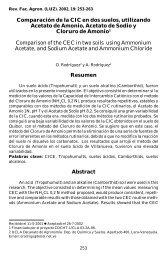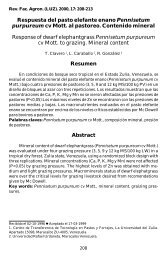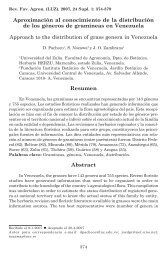Efecto de extractos de oregano (Origanum vulgare L.) ante la ...
Efecto de extractos de oregano (Origanum vulgare L.) ante la ...
Efecto de extractos de oregano (Origanum vulgare L.) ante la ...
Create successful ePaper yourself
Turn your PDF publications into a flip-book with our unique Google optimized e-Paper software.
Rev. Fac. Agron. (LUZ). 2011, 28 Supl. 1: 628-635<br />
<strong>Efecto</strong> <strong>de</strong> <strong>extractos</strong> <strong>de</strong> <strong>oregano</strong> (<strong>Origanum</strong> <strong>vulgare</strong> L.)<br />
<strong>ante</strong> <strong>la</strong> oxidación en aceite vegetal comestible<br />
Effect of <strong>oregano</strong> (<strong>Origanum</strong> <strong>vulgare</strong> L.) extracts before<br />
oxidation in edible vegetable oil<br />
D.R. Belén-Camacho* 1 , I. López 1 , C. Sojo 1 , O. Linares 2 , C. Medina-Martínez 1 ,<br />
D. García-Pantaleón 1 y M.J. Moreno-Álvarez 1<br />
1<br />
Universidad Nacional Experimental Simón Rodríguez, Núcleo<br />
Canoabo-Venezue<strong>la</strong>, Ingeniería <strong>de</strong> Alimentos: Laboratorio <strong>de</strong><br />
Biomolécu<strong>la</strong>s. 2 Empresa COPOSA, Acarigua-Venezue<strong>la</strong>.<br />
Resumen<br />
El objetivo <strong>de</strong> este trabajo fue evaluar <strong>la</strong> acción <strong>ante</strong> <strong>la</strong> oxidación lipídica<br />
<strong>de</strong> <strong>extractos</strong> orgánicos <strong>de</strong> orégano (<strong>Origanum</strong> <strong>vulgare</strong> L.). Se utilizaron dos<br />
muestras <strong>de</strong> hojas <strong>de</strong> orégano: hojas frescas y hojas <strong>de</strong>secadas al sol. Ambas<br />
fueron molidas y extraídas con 100 mL <strong>de</strong> propilenglicol (PG), empleando dos<br />
proporciones <strong>de</strong> hojas: E1 (3 g <strong>de</strong> hojas frescas) y E2 (0,35 g <strong>de</strong> hojas <strong>de</strong>secadas).<br />
Los <strong>extractos</strong> fueron adicionados a aceite <strong>de</strong> soya <strong>de</strong>sodorizado en proporciones<br />
<strong>de</strong>: 0,5%; 1,0% y 1,5%. El extracto E2 (concentración total <strong>de</strong> fenoles 0,124 mg<br />
equivalentes <strong>de</strong> ácido tánico) mostró acción antioxid<strong>ante</strong> (P
Rev. Fac. Agron. (LUZ). 2011, 28 Supl. 1: 628-635<br />
Introducción<br />
La oxidación lipídica es uno <strong>de</strong><br />
los problemas <strong>de</strong> mayor preocupación<br />
en el área <strong>de</strong> alimentos <strong>de</strong>bido a los<br />
efectos adversos que ocasiona en <strong>la</strong><br />
calidad <strong>de</strong> los productos y en <strong>la</strong> salud<br />
humana. La adición <strong>de</strong> antioxid<strong>ante</strong>s<br />
sintéticos es una <strong>de</strong> <strong>la</strong>s formas más<br />
empleadas para <strong>la</strong> prevención <strong>de</strong> <strong>la</strong><br />
oxidación <strong>de</strong> los componentes grasos.<br />
Sin embargo, se ha cuestionado el uso<br />
<strong>de</strong> estas sustancias <strong>de</strong>bido a que su<br />
ingesta se ha re<strong>la</strong>cionado con el <strong>de</strong>sarrollo<br />
<strong>de</strong> enfermeda<strong>de</strong>s cancerígenas,<br />
situación que ha aumentado el interés<br />
por fuentes naturales con capacidad<br />
antioxid<strong>ante</strong> (Yanishlieva et al.,<br />
2006).<br />
El orégano (<strong>Origanum</strong> <strong>vulgare</strong><br />
L.) es un ejemplo <strong>de</strong> estos recursos.<br />
Tanto <strong>la</strong>s hojas <strong>de</strong> orégano como los<br />
<strong>extractos</strong> obtenidos <strong>de</strong> éstas, han inhibido<br />
<strong>la</strong> oxidación lipídica en sistemas<br />
alimentarios, atribuyéndose <strong>la</strong><br />
acción a <strong>la</strong> presencia <strong>de</strong> varios compuestos<br />
fenólicos entre los que <strong>de</strong>stacan:<br />
ácido rosmarínico, ácido gálico,<br />
ácido cafeico, ácido protocatechuico,<br />
<strong>de</strong>rivados <strong>de</strong> estos ácidos, f<strong>la</strong>vonoi<strong>de</strong>s,<br />
carvacrol y timol; adicionalmente, se<br />
han i<strong>de</strong>ntificado algunos tocoferoles.<br />
Para <strong>la</strong> extracción <strong>de</strong> estos compuestos,<br />
se ha utilizado como disolvente<br />
metanol y otras sustancias que suelen<br />
ser tóxicas, lo que limita <strong>la</strong> aplicación<br />
<strong>de</strong> estos <strong>extractos</strong> en alimentos<br />
(Yanishlieva et al., 2006). Esta<br />
<strong>de</strong>sventaja obliga a <strong>la</strong> búsqueda <strong>de</strong><br />
solventes <strong>de</strong> aceptación en alimentos.<br />
El propilenglicol pue<strong>de</strong> servir <strong>de</strong> vehículo<br />
y <strong>de</strong> agente extractor alternativo<br />
para antioxid<strong>ante</strong>s <strong>de</strong> naturaleza<br />
fenólica.<br />
Introduction<br />
Lipid oxidation is one of<br />
problems of higher concern in feeding<br />
area because the adverse effect that<br />
cause in products quality and on<br />
human health. The addition of<br />
synthetic antioxidants is one of more<br />
used ways to prevent oxidation of fatty<br />
components. However, the use of<br />
these substances has been questioned<br />
because its consumption have been<br />
re<strong>la</strong>ted to <strong>de</strong>velopment of carcinogen<br />
diseases, which has increased the<br />
interest for natural sources with<br />
antioxidant capacity (Yanishlieva et<br />
al., 2006).<br />
The <strong>oregano</strong> (<strong>Origanum</strong> <strong>vulgare</strong><br />
L.) is an example of these resources.<br />
Both <strong>oregano</strong> leaves and extracts<br />
obtained from them, have inhibit the<br />
lipid oxidation in food systems, being<br />
the action attributed to the presence<br />
of several phenolic compounds like:<br />
rosmarinic acid, galic acid, caffeic<br />
acid, protocatechuic acid, <strong>de</strong>rivates<br />
from these acids, f<strong>la</strong>vonoids, carvacrol<br />
and thymol; additionally, some<br />
tocopherols have been i<strong>de</strong>ntified. For<br />
the extraction of these compounds,<br />
methanol have been used like solvent<br />
just like other substances usually<br />
toxic, which limit the application of<br />
these extracts in foods (Yanishlieva<br />
et al., 2006). This disadvantage forces<br />
to looking the acceptance of solvents<br />
in foods. The propylene glycol can<br />
function as vehicle and like<br />
alternative extractor agent for<br />
antioxidants of phenolic nature.<br />
The purpose of this research was<br />
to evaluate the behavior of <strong>oregano</strong><br />
leaves extracts obtained with<br />
propylene glycol, like possible<br />
629
Belén-Camacho et al.<br />
El objetivo <strong>de</strong> este trabajo fue<br />
evaluar el comportamiento <strong>de</strong> <strong>extractos</strong><br />
<strong>de</strong> hojas <strong>de</strong> orégano obtenidos con<br />
propilenglicol, como posibles agentes<br />
antioxid<strong>ante</strong>s en aceite <strong>de</strong>sodorizado<br />
<strong>de</strong> soya.<br />
Materiales y métodos<br />
Muestra <strong>de</strong> orégano<br />
Se recolectaron aleatoriamente<br />
dos muestras <strong>de</strong> 1 kg <strong>de</strong> hojas <strong>de</strong> orégano,<br />
cada una, cultivado en <strong>la</strong> Universidad<br />
Nacional Experimental<br />
Simón Rodríguez, municipio Canoabo,<br />
estado Carabobo, República<br />
Bolivariana <strong>de</strong> Venezue<strong>la</strong>.<br />
Aceite vegetal<br />
Se empleó aceite <strong>de</strong> soya recién<br />
<strong>de</strong>sodorizado donado por <strong>la</strong> Empresa<br />
COPOSA (Acarigua, estado Portuguesa).<br />
Procesamiento <strong>de</strong> <strong>la</strong>s hojas<br />
<strong>de</strong> orégano<br />
Una <strong>de</strong> <strong>la</strong>s muestras <strong>de</strong> hojas se<br />
mantuvo fresca y <strong>la</strong> otra fue secada<br />
en un prototipo <strong>de</strong> secador so<strong>la</strong>r<br />
artesanal. Se les <strong>de</strong>terminó el contenido<br />
<strong>de</strong> humedad (AOAC, 1990). Las<br />
hojas fueron molidas en un procesador<br />
<strong>de</strong> alimentos doméstico marca Oster.<br />
Extracción con propilenglicol<br />
Con base en ensayos previos, se<br />
procedió a obtener dos <strong>extractos</strong> <strong>de</strong><br />
orégano, <strong>de</strong>finidos por <strong>la</strong> re<strong>la</strong>ción hoja/<br />
propilenglicol:<br />
-E1: 3 g <strong>de</strong> hojas frescas/100 mL<br />
<strong>de</strong> propilenglicol.<br />
-E2: 0,35 g <strong>de</strong> hojas <strong>de</strong>secadas/<br />
100 mL <strong>de</strong> propilenglicol.<br />
El orégano fue colocado en el<br />
propilenglicol, se mantuvo en reposo<br />
dur<strong>ante</strong> 21 días, tapado el recipiente<br />
a temperatura ambiente (30ºC ± 2ºC).<br />
antioxidants agents in soybean<br />
<strong>de</strong>odorized oil.<br />
Materials and methods<br />
Orégano samples<br />
Two samples of 1 kg of <strong>oregano</strong><br />
leaves were collected, each of them<br />
cultivated in the Universidad Nacional<br />
Experimental Simón Rodríguez,<br />
Canoabo municipality, Carabobo<br />
satte, República Bolivariana <strong>de</strong> Venezue<strong>la</strong>.<br />
Vegetal oil<br />
Soybean recently <strong>de</strong>odorized<br />
supplied by the COPOSA Enterprise<br />
(Acarigua, Portuguesa state) was<br />
used.<br />
Oregano leaves processing<br />
One of leaves samples was kept<br />
fresh and the other one was dried in<br />
a prototype of handma<strong>de</strong> so<strong>la</strong>r drier.<br />
The humidity content was <strong>de</strong>termined<br />
(AOAC, 1990). Leaves were groun<strong>de</strong>d<br />
in a processor of domestic food, mark<br />
Oster.<br />
Extraction with propylene<br />
glycol<br />
Based on previous studies, two<br />
<strong>oregano</strong> extracts were obtained,<br />
<strong>de</strong>fined by the re<strong>la</strong>tionship leaf/<br />
propylene glycol:<br />
-E1: 3 g of fresh leaves/100 mL<br />
of propylene glycol.<br />
-E2: 0.35 g of <strong>de</strong>siccate leaves/<br />
100 mL of propylene glycol.<br />
The <strong>oregano</strong> was p<strong>la</strong>ced on<br />
propylene glycol; it was kept into rest<br />
during 21 days, closed to the recipient<br />
to environmental temperature (30ºC<br />
± 2ºC). Then, it was filtered through<br />
filter paper, filtrates (extracts) were<br />
kept into amber g<strong>la</strong>ss f<strong>la</strong>sks provi<strong>de</strong>d<br />
with screw top and stored into<br />
630
Rev. Fac. Agron. (LUZ). 2011, 28 Supl. 1: 628-635<br />
Luego, se filtró a través <strong>de</strong> papel <strong>de</strong><br />
filtro, guardándose los filtrados (<strong>extractos</strong>)<br />
en frascos <strong>de</strong> vidrio ámbar<br />
provistos <strong>de</strong> tapas con rosca y almacenados<br />
en refrigeración (10ºC ± 1ºC).<br />
Cada extracción se realizó por triplicado.<br />
Contenido total <strong>de</strong> compuestos<br />
fenólicos y <strong>de</strong> clorofi<strong>la</strong>s en los<br />
<strong>extractos</strong> obtenidos<br />
Se <strong>de</strong>terminó el contenido total<br />
<strong>de</strong> fenólicos (Arroyo et al., 2007) y <strong>la</strong>s<br />
concentraciones <strong>de</strong> clorofi<strong>la</strong> A y clorofi<strong>la</strong><br />
B (Casas-Forero et al., 2007).<br />
Medición <strong>de</strong> <strong>la</strong> estabilidad<br />
oxidativa<br />
A muestras <strong>de</strong>l aceite <strong>de</strong> soya<br />
<strong>de</strong>sodorizado se les adicionó <strong>extractos</strong><br />
<strong>de</strong> orégano en propilenglicol en<br />
cantida<strong>de</strong>s en <strong>la</strong>s siguientes proporciones:<br />
0,5%; 1,0% y 1,5% (m/m). Una<br />
muestra <strong>de</strong> aceite no fue adicionada<br />
<strong>de</strong> antioxid<strong>ante</strong> ni <strong>de</strong> <strong>extractos</strong>. A<br />
cada muestra <strong>de</strong> aceite se le <strong>de</strong>terminó<br />
<strong>la</strong> estabilidad a <strong>la</strong> oxidación,<br />
expresada en horas, en un equipo<br />
Rancimat marca Metrohm mo<strong>de</strong>lo<br />
743, operado a 120ºC y flujo <strong>de</strong> aire<br />
20 L.h -1 .<br />
Análisis estadístico<br />
Se aplicó un diseño <strong>de</strong> bloques<br />
al azar, análisis <strong>de</strong> varianza y prueba<br />
<strong>de</strong> Tukey (P
Belén-Camacho et al.<br />
Contenidos totales <strong>de</strong> compuestos<br />
fenólicos en los <strong>extractos</strong><br />
Los contenidos totales <strong>de</strong> fenoles<br />
<strong>de</strong> los <strong>extractos</strong> obtenidos (cuadro 1),<br />
presentaron diferencias significativas<br />
(P
Rev. Fac. Agron. (LUZ). 2011, 28 Supl. 1: 628-635<br />
portamientos antioxid<strong>ante</strong>s y prooxid<strong>ante</strong>s<br />
(figura 1). El extracto E1<br />
actuó como pro-oxid<strong>ante</strong> en todas <strong>la</strong>s<br />
concentraciones evaluadas, ya que<br />
aportó valores <strong>de</strong> estabilidad menores<br />
que el valor <strong>de</strong>l aceite sin<br />
antioxid<strong>ante</strong> (control). El extracto E2<br />
actuó como antioxid<strong>ante</strong> a <strong>la</strong>s concentraciones<br />
0,5% y 1,00%, con estabilidad<br />
<strong>de</strong> 3,30 h y 3,51 h. Los aumentos<br />
en <strong>la</strong> estabilidad <strong>de</strong>l aceite <strong>de</strong> soya por<br />
<strong>la</strong> acción <strong>de</strong> los <strong>extractos</strong> <strong>de</strong> orégano<br />
en propilenglicol fueron significativos<br />
(P
Belén-Camacho et al.<br />
Figura 1. Estabilidad oxidativa <strong>de</strong>l aceite <strong>de</strong> soya adicionado <strong>de</strong><br />
<strong>extractos</strong> <strong>de</strong> orégano en propilenglicol.<br />
Figure 1. Oxidative estability of soybean oil additioned of <strong>oregano</strong><br />
extract with propylene glycol.<br />
Cuadro 2. Clorofi<strong>la</strong>s A y B en los <strong>extractos</strong> <strong>de</strong> orégano*.<br />
Table 2. Chlorophyll A and B in <strong>oregano</strong> extract*.<br />
Extracto Clorofi<strong>la</strong> A (mg.mL -1 ) Clorofi<strong>la</strong> B (mg.mL -1 )<br />
1 10,29±0,52 a 4,27±0,23 a<br />
2 1,92±0,12 b 0,34±0,03 b<br />
*Valores promedios (n = 3) ± <strong>de</strong>sviación estándar. Letras diferentes en los superíndices <strong>de</strong><br />
una misma columna indican diferencias significativas (P
Rev. Fac. Agron. (LUZ). 2011, 28 Supl. 1: 628-635<br />
actividad antioxid<strong>ante</strong> se <strong>de</strong>be utilizar<br />
hojas <strong>de</strong>secadas, siempre que su<br />
concentración en el aceite no sea mayor<br />
<strong>de</strong> 1,0%.<br />
Literatura citada<br />
AOAC. 1990. Oficial Methods of Análisis.<br />
15 th ed. Association of Oficial<br />
Analytical Chemists, Washington<br />
DC.<br />
Arroyo, I.J., H. Y. Hernán<strong>de</strong>z y M. T.<br />
Cruz. 2007. Determinación <strong>de</strong> <strong>la</strong><br />
re<strong>la</strong>ción entre el contenido <strong>de</strong><br />
compuestos fenólicos totales y<br />
actividad antioxid<strong>ante</strong> en<br />
<strong>extractos</strong> <strong>de</strong> orégano mexicano<br />
(Limpia spp.) seco y fresco.<br />
Alimentos Ciencia e Ingeniería.<br />
16(2):179-180.<br />
Casas-Forero, N., I. Sotelo-Díaz y G. Caez-<br />
Ramírez. 2007. <strong>Efecto</strong> <strong>de</strong>l<br />
tratamiento térmico sobre <strong>la</strong><br />
<strong>de</strong>gradación <strong>de</strong> <strong>la</strong> clorofi<strong>la</strong> y <strong>la</strong><br />
pérdida <strong>de</strong> color en una mezc<strong>la</strong> <strong>de</strong><br />
vegetales. Alimentos Ciencia e<br />
Ingeniería. 16(3):2 11-213.<br />
Choe, E. and D. B. Min. 2005. Chemistry<br />
and reactions of reactive oxygen<br />
species in foods. Journal of Food<br />
Science. 70(9):R142-R159.<br />
Yanishlieva, N.V., E. Marinova and J.<br />
Pokorny. 2006. Natural<br />
antioxidants from herbs and<br />
spices. European Journal of Lipid<br />
Science and Technology.<br />
108(9):776-793.<br />
635



